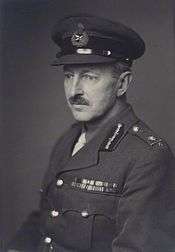Walter Clutterbuck
| Walter Clutterbuck | |
|---|---|
 | |
| Born |
17 November 1894 Hardenhuish House, Chippenham, Wiltshire, England |
| Died |
2 February 1987 (aged 92) Wensleydale, North Yorkshire, England |
| Allegiance |
|
| Service/branch |
|
| Years of service | 1913–1946 |
| Rank | Major-General |
| Unit | Royal Scots Fusiliers |
| Commands held |
2nd Battalion, Royal Scots Fusiliers 10th Infantry Brigade 1st Infantry Division 55th (West Lancashire) Infantry Division |
| Battles/wars |
World War I World War II |
| Awards |
Distinguished Service Order Military Cross |
Major-General Walter Edmond Clutterbuck DSO MC (17 November 1894 – 2 February 1987) was a British Army officer who fought during both World War I and World War II.
Military career
Born on 17 November 1894, Walter Edmond Clutterbuck was educated at Cheltenham College and later entered the Royal Military College, Sandhurst, where, in 1913, he was commissioned as a second lieutenant into the Royal Scots Fusiliers of the British Army.[1] He was sent to the 2nd Battalion of his regiment, then stationed in Gibraltar. Shortly after World War I began he was sent, with his battalion, to England, where it became part of the 21st Brigade of the 7th Division, soon after the outbreak of war. The battalion arrived on the Western Front in October where it fought in the First Battle of Ypres and sustained very heavy casualties. He later served in Gallipoli, Egypt, Palestine and Southern Russia.[2] He ended the war having been awarded the Military Cross, wounded twice and mentioned in dispatches.[1] His older brother, David Clutterbuck, a lieutenant in the Royal Field Artillery, was killed in May 1917. In October 1919 he married Gwendolin Atterbury Younger; they had one son and two daughters.[3]
He spent most of the interwar period as a captain [1]and, in 1939, he became Commanding Officer (CO) of the 1st Battalion, Royal Scots Fusiliers, then in Poona, India.[2] With his battalion, he returned to the United Kingdom in July 1940, ten months after the outbreak of World War II, and there the battalion became part of the 29th Independent Infantry Brigade Group. In October he was promoted to command the 10th Infantry Brigade, part of the 4th Infantry Division, stationed in the United Kingdom awaiting a German invasion.[1] In November 1941 he was promoted to the general officer rank of major-general and became General Officer Commanding (GOC) of the 1st Infantry Division.[2] In June 1942 the division was converted into a 'mixed' division of two infantry brigades and one tank brigade, before reverting to a standard infantry division in November.[2] In late February 1943 the division left the United Kingdom, destined for French North Africa, where it fought in the final stages of the Tunisian Campaign.[1] Despite suffering heavy casualties the division earned three Victoria Crosses and captured thousands of Axis soldiers. In mid-June, the division took part in Operation Corkscrew, the Allied invasion of the Italian island of Pantelleria[1] and, despite Clutterbuck's fears that the division would suffer heavy losses, casualties were minimal, with only one man being killed (by a mule) and the Italian garrison of 14,000 surrendered.[1] The division returned to North Africa soon after. However, in August he returned to the United Kingdom where he became GOC of the 55th (West Lancashire) Infantry Division.[1]
After the war he was Head of the British Military Mission to Egypt before retiring from the army in 1946.[2]
References
- Biographical Dictionary of British Generals of the Second World War, Nick Smart. ISBN 1-84415-049-6.
| Military offices | ||
|---|---|---|
| Preceded by Edwin Morris |
GOC 1st Infantry Division 1941–1943 |
Succeeded by Gerald Templer |
| Preceded by Hugh Hibbert |
GOC 55th (West Lancashire) Infantry Division 1943–1944 |
Succeeded by Horatio Berney-Ficklin |